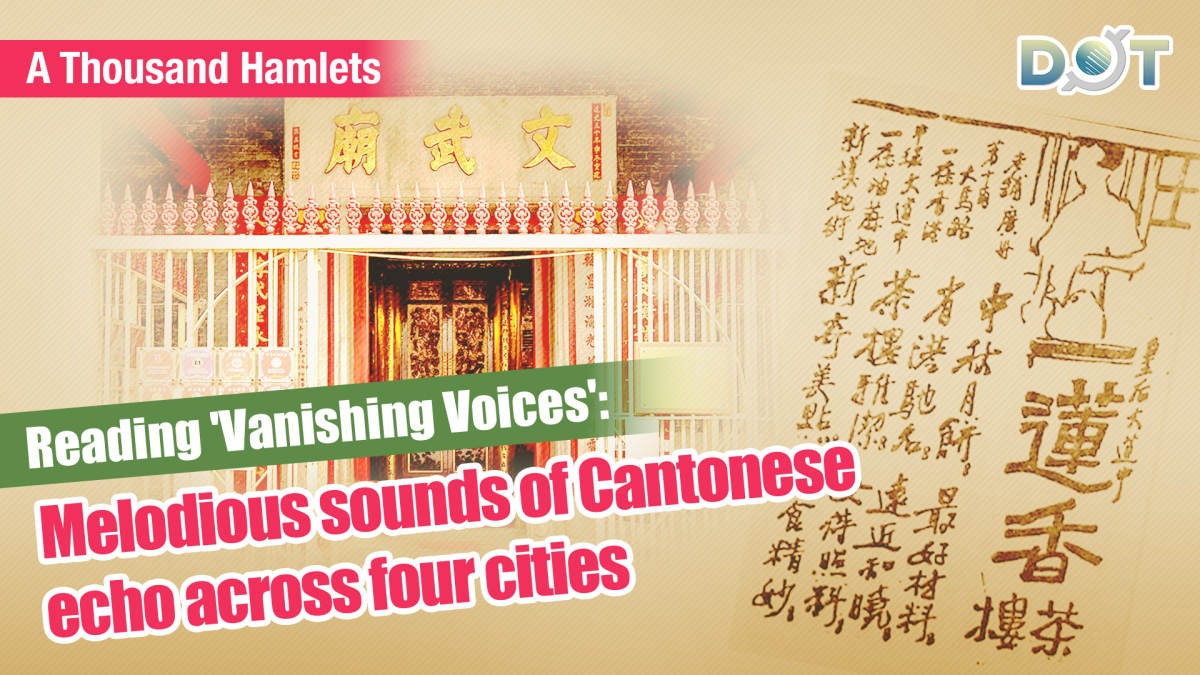
By Xu Xi
Recently, I traveled to Shanghai, where a friend had specially booked a highly-rated local cuisine restaurant, promising to treat us to authentic Shanghai dishes. After we sat down, another table of Hong Kong guests arrived, apparently referred by acquaintances, prompting the restaurant owner to personally greet them and introduce the dishes. During the conversation, the owner suddenly began speaking Cantonese with the guests, which surprised me a lot. How could a native Shanghainese speak fluent Cantonese? Upon closer listening, I learned that the owner's ancestral home was in Zhongshan, Guangdong Province, and his grandfather's generation had moved to Shanghai for business and settled there. Although he was of the third generation, he could still speak Cantonese. This small anecdote on the journey sparked my curiosity about the flow of people and cultural connections between Guangdong and Shanghai, and Professor May Bo CHING's new book, Vanishing Voices: The Past Tense of Guangzhou, Hong Kong, Macao, and Shanghaianswered my questions. Prof. CHING is a renowned scholar at the Department of Chinese and History, the City University of Hong Kong, and she is currently working on how the regional culture of South China takes shape in a trans-regional context in terms of sound, colour, and taste. From a fresh perspective, this book uses sound as a thread to connect the cultural history of Guangzhou, Hong Kong, Macau, and Shanghai from the 18th century to the mid-20th century. It explores how Cantonese opera, music, and pop songs utilized modern media such as gramophone records, radio, and films to create a unique Cantonese-language soundscape, tightly linking the popular cultures of these four cities.
From a linguistic perspective, what is referred to as "Cantonese" is not a single entity. This is because 'Cantonese' is an umbrella term that can be further divided into sub-dialects such as "Guangfu dialect 廣府話" and "Siyi dialect 四邑話," each of which exhibits varying degrees of differences in tone, vocabulary, and grammar across different regions. Today, on social media, some influencers often try to catch eyeballs by discussing the differences between "Guangzhou Cantonese" and "Hong Kong Cantonese." However, historically speaking, the accent differences between Guangzhou and Hong Kong are not so significant, as both regions speak the "Xiguan (Sai Kwan) dialect 西關話." Professor CHING points out that the "Canton" in "Cantonese" actually does not refer to Guangdong Province but to the provincial capital, Guangzhou. "Cantonese" plainly means "pure vernacular of the provincial capital 省城白話," where "pure" signifies "authentic" without any regional dialectal influences. The most "authentic" vernacular is widely recognized as Guangzhou's "Xiguan dialect".
What is most interesting is that although "Xiguan dialect" became the standard pronunciation of Cantonese, the "Xiguan" district was not located within the city walls of the provincial capital. Geographically, "Xiguan" was located to the west of the city walls of Guangzhou during the Ming and Qing dynasties, originally a tidal flat between rivers and the sea. In 1757, the Qing government restricted the port for foreign trade only to Guangzhou, but strictly prohibited foreign merchants from entering the city to do business. Instead, they were required to establish their trading posts west of the city walls for commercial activities. Subsequently, Xiguan gradually developed and prospered due to commercial activities, attracting a large influx of people. A group of Chinese merchants who profited from international trade emerged and began purchasing land to build residences there. The prosperous economic environment also gave rise to a vibrant cultural scene: numerous theaters, taverns, academies, and charitable halls began to appear in this area.
Cantonese has multiple dialects, and when outsiders learn Cantonese, they must choose one as the standard. Among these dialects, "Xiguan dialect" stands out as the universally recognized model for imitation, largely thanks to the economic and cultural capital represented by the wealthy merchant families behind it. According to Professor CHING's research, as early as 1883, James Dyer Ball, a British national born in Guangzhou, stated in the preface of his textbook Cantonese Made Easy that readers should use "Xiguan dialect" as the standard for learning the "correct pronunciation of pure Cantonese". In 1947, renowned linguist Zhao Yuanren noted in Cantonese Primer that the Xiguan area was home to some old prominent families whose pronunciation reflected certain social prestige and cultural refinement. Precisely because it was regarded as the representative of "authentic" Cantonese, the "Xiguan accent" became the standard for the tonal patterns and rhythms of Cantonese opera, music, and later Cantonese pop songs that emerged in the provincial capital, and spread to various regions through these artistic works.
Sounds spread with population migration. In the mid-19th century, after Hong Kong was opened as a treaty port, Chinese people from various regions came to engage in trade and entrepreneurship, bringing their own dialects and regional accents. However, the Chinese immigrants in Hong Kong longed for the culture of Guangzhou, so they named the streets in Hong Kong island after places like "Wing On Street," "Tung Man Street," and "Hing Lung Street" in the Xiguan area. Many of the wooden carvings and bronze artifacts in the Man Mo Temple were actually crafted in workshops in the Xiguan area and then transported to Hong Kong. Cantonese also became the common language of the Hong Kong people. In 1865, the Hong Kong Canton & Macao Steamboat Company was established, and in 1911, the Kowloon-Canton Railway was fully completed and put into operation, making travel between Guangzhou and Hong Kong increasingly convenient and frequent. Hong Kong restaurants hired renowned chefs from Guangzhou to attract customers, and in teahouses on both sides, guests could enjoy the beautiful Cantonese music sung by singers to entertain them. The most vibrant and popular Cantonese-language art form at the time was Cantonese opera, commonly known as "Guangfu Grand Opera." The earliest Cantonese opera troupes primarily performed in rural areas, traveling by "red boats" across the Pearl River Delta, and were relatively small in scale. With the development of commercialization and urbanization, the performance market expanded, and by the late Qing and early Republican eras, larger-scale troupes with extensive repertoires and well-equipped productions emerged. These troupes were typically affiliated with theatrical companies, had regular theaters, and toured between Guangdong and Hong Kong on a long-term basis, hence the term "Cross-Border Troupe/Canton-Hong Kong troupe 省港班." The urbanization of Cantonese opera began in Guangzhou and flourished in the 1920s, with many Guangzhou theatrical companies investing in the construction of theaters in Hong Kong. In the 1930s, with the Japanese invasion and the fall of Guangzhou in 1938, the economy declined, and the Cantonese opera market gradually faded. However, Cantonese opera did not completely disappear. During the War of Resistance, Hong Kong and Macau became refuge sites for Cantonese opera artists. Yam Kim-fai, Pak Suet Sin, and other famous performers continued to perform on stage, using the familiar sounds of Cantonese opera to comfort the displaced people and preserve the nation's cultural heritage.
The three cities of Guangzhou, Hong Kong, and Macao are geographically connected, share the same language, and have similar customs. It is no surprise that Cantonese art is popular in this region, but why did it spread as far as Shanghai, thousands of miles away? The answer lies in the large number of Cantonese people living there. After the Opium War, several treaty ports were opened, and because they had long experience dealing with foreign merchants, large numbers of Cantonese people went to these new ports in search of opportunities. By around 1934, over 300,000 Guangdong natives were residing in Shanghai, providing a stable market for Cantonese opera and music, attracting many renowned Cantonese opera performers to perform there. Among the Cantonese expatriates in Shanghai were many wealthy merchants who, longing for their hometown, enthusiastically established provincial fellow associations and sponsored cultural activities, further fueling the spread of Cantonese opera and music. For example, the three major department stores founded by Cantonese merchants—Wing On, Sincere, and Sun Sun—all had their own Cantonese opera troupes or Cantonese music ensembles. The audience's demand for Cantonese music was so strong that, starting with the establishment of the first radio station in 1923, several radio stations in Shanghai began broadcasting Cantonese music, opera, and news. In the 1930s, the number of radio stations broadcasting Cantonese programs once reached as many as sixteen, accounting for nearly half of all radio stations in the city. By 1941, the Anhua Radio Station, founded by Cantonese businessman Huang Yinchu, broadcast Cantonese programs exclusively throughout the day.
Shanghai in the first half of the 20th century was a cultural hub where Eastern and Western cultures converged, and record and film companies thrived. Traditional Cantonese music also flourished due to new technologies, enriching itself through collisions and fusions with other musical forms. Cantonese opera enthusiast Qian Guangren first recorded Cantonese opera records for the Great China Gramophone Company, and then founded the New Moon Gramophone Company in 1926, producing a large number of Cantonese opera and Cantonese music records, allowing overseas opera enthusiasts to enjoy them as well. Shanghai Tianyi Company and Mingxing Company invested in the production of several Cantonese films in the 1930s, which were exported to the Southeast Asian market. Hu Die, the "Movie Queen" from Heshan, Guangdong, spoke fluent Cantonese in her lead role in The Red Boat Chronicles, and critics praised her as having a "delicate and melodious voice, with Cantonese opera singing and speaking being the most pleasing to the ear". Born in Zhongshan and raised in Shanghai, Lv Wencheng(Lui Man Shing), later revered as a master of Cantonese music, not only incorporated Western instruments like the violin into his performances but also created the famous Cantonese music piece "Autumn Moon over the Calm Lake" (Pinghu Qiyue), inspired by Jiangnan silk and bamboo music. Through records and films produced in Shanghai, the Cantonese soundscape not only developed further by absorbing elements from both Chinese and Western music but also crossed the seas, becoming widely popular among overseas Chinese communities.
As time passes, the once vibrant scene of Cantonese being spoken and listened to simultaneously in four cities is gradually fading away to varying degrees. People lament the declining number of Cantonese speakers, the closure of Cantonese radio stations, and the younger generation's inability to pronounce words accurately or produce proper tones—exactly the concerns Professor CHING expresses in her book. However, while Cantonese may no longer regain its former glory, we can still hear its voice in various corners of new media today. The recently viral global hit song "Da Zhan Hong Tu" features a sample from the classic Cantonese opera "Di Nu Hua" in its opening; Jimmy O. Yang, a stand-up comedian born and raised in Hong Kong who has gained fame across the Pacific, incorporates many Cantonese elements into his jokes; On Xiaohongshu, the dialect blogger "Maxim," a 90s-born Beijing native, fell in love with Cantonese through watching Bruce Lee's films and mastered it with perfect pronunciation. His videos popularized the Guangzhou Cantonese Pronunciation Dictionary and inspired more young people from other regions to learn Cantonese. Today, while Cantonese may no longer resonate as strongly as it once did, its echoes still linger in cyberspace, continuing to carry forward the rich and diverse Guangfu culture.
Xu Xi is a literary scholar teaching at BNBU, Zhuhai. Xu holds a PhD from HKU.
The views do not necessarily reflect those of DotDotNews.
Related Readings:
A Thousand Hamlets | The philosophy of 'willing to act, joyful to endure' in 'Wild Grass'
A Thousand Hamlets | Love in wartime tram: 'Liminal romance' of Eileen Chang's 'Sealed Off'




















Comment